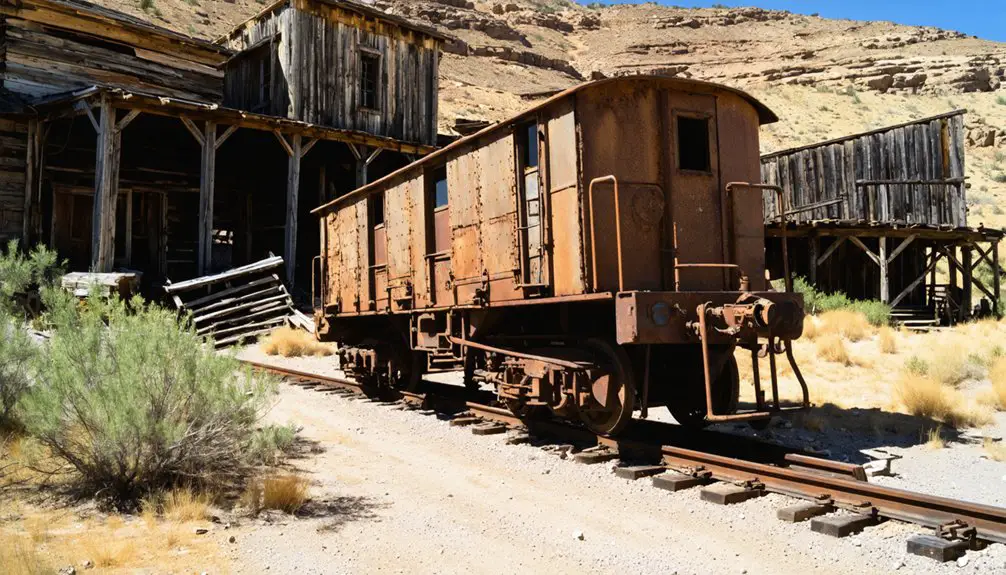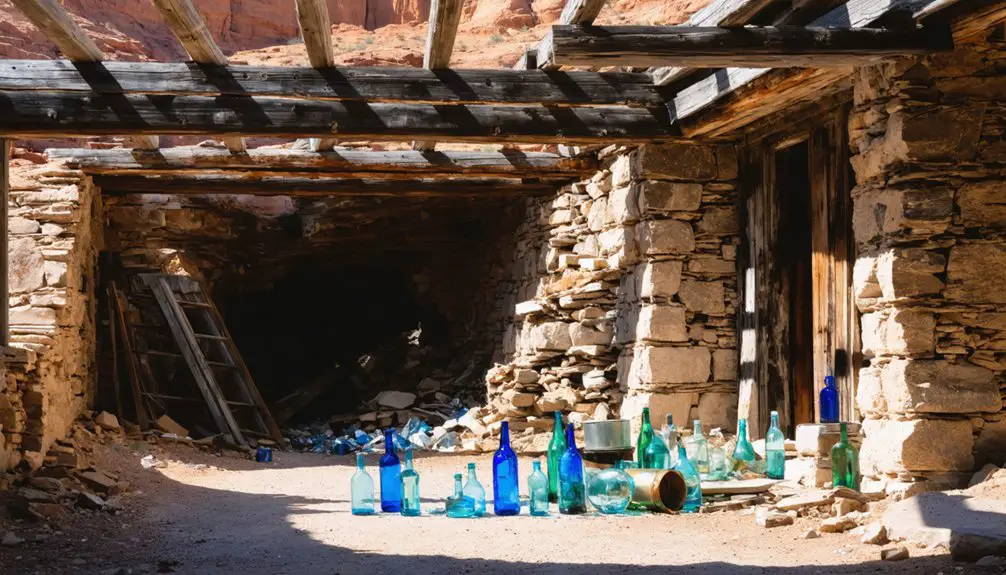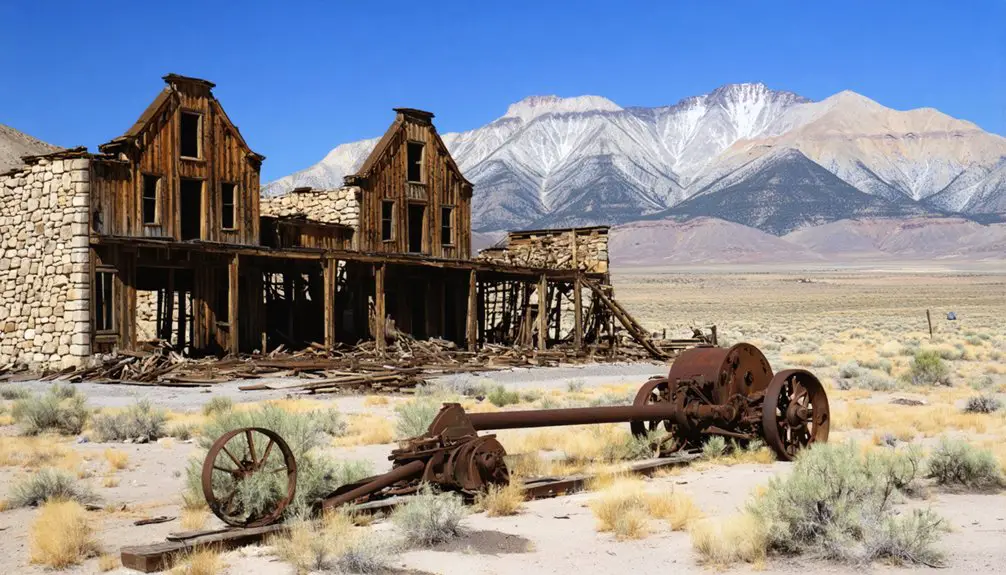You’ll find Bullionville nestled at 9,000 feet in Utah’s Uintah Mountains, where L.P. Dyer’s 1882 copper discovery sparked a bustling mining settlement. The town rapidly grew to 500 residents, featuring multiple mills that processed valuable ore worth up to $200 per ton. While the miners’ wooden cabins and ore processing facilities once hummed with activity, Bullionville’s eventual decline left behind compelling traces of America’s western mining heritage.
Key Takeaways
- Located at 9,000+ feet in Utah’s Uintah Mountains, Bullionville was established as a copper mining town after L.P. Dyer’s 1882 discovery.
- The town flourished in the 1870s, growing from 96 to 500 residents with a five-stamp mill and railroad connection.
- Mining operations processed significant amounts of silver ore, with Raymond & Ely company contributing $3.7 million to regional output in 1872.
- Residents lived in wooden cabins, working demanding schedules in mines and mills while adapting to harsh alpine conditions.
- The town declined and was abandoned due to depleted mineral resources, poor road conditions, and economic instability.
Location in the Uintah Mountains
Nestled high in Utah’s Uintah Mountains at over 9,000 feet elevation, Bullionville’s remote location exemplifies the rugged terrain that challenged early mining settlements in the American West.
You’ll find this ghost town at approximately 40.701° N and 109.573° W, positioned within the northwestern section of Uintah County where dramatic geographic features dominate the landscape.
The site’s alpine climate creates distinct seasonal conditions that influence accessibility. You can reach Bullionville by traveling 23 miles north of Vernal on US 191, then following Red Cloud Loop Road westward through Kane Hollow.
The surrounding environment reflects the broader Uintah Basin’s character, with the Green River flowing to the south and Dyer Mountain rising nearby. The area’s high-altitude setting showcases the raw, untamed nature of Utah’s mountainous region. Near the townsite, the small copper mine that gave Bullionville its name still stands as a testament to its mining heritage. The area is accessible via a steep two-track road that leads visitors to the historic site.
The Origins of the Copper Mine
While early prospectors initially sought gold in Utah’s Uintah Mountains, the discovery of substantial copper deposits in the early 1880s sparked Bullionville’s mining legacy. L.P. Dyer’s copper discovery in 1882 quickly led to the establishment of mining claims throughout the area, giving rise to a bustling settlement named for its rich copper “bullion” ore.
You’ll find the copper deposits nestled within the region’s sedimentary formations, primarily limestone and dolomite. These copper-bearing veins formed when mineralizing fluids seeped through rock fissures over geological time. The deposits contain distinctive calcite and quartz veins that characterize the local geology. Like the Highland Boy mine, which made Utah’s first large copper shipment in 1896, Bullionville’s mines contributed to the territory’s emerging copper industry.
Early mining techniques focused on underground extraction of high-grade veins, supported by basic smelting operations that processed the copper sulfide ore. Though the deposits proved limited in extent, they sustained Bullionville’s economic activity through the late 19th century.
Early Settlement and Development
You’ll find that Bullionville’s early settlement was driven by its strategic position near Meadow Valley Creek, where five stamp mills processed silver ore from nearby Pioche mines.
Pioneer families established themselves around these industrial operations, with the population growing from 96 residents in 1870 to approximately 500 by 1875. The town’s founders John H. Ely and Raymond initially started operations by moving a five-stamp mill from Hiko.
The completion of the Pioche and Bullionville Railroad in 1873 created essential transportation links, enabling efficient ore movement between the mines and mills while supporting the town’s rapid expansion. The town’s development was further enhanced by the establishment of an iron foundry, the first of its kind in eastern Nevada.
Mining Drives Town Growth
Three critical factors drove Bullionville’s establishment and early growth: abundant water resources, strategic proximity to Pioche’s silver mines, and the arrival of milling operations.
You’ll find that the town’s origin traces to 1870 when miners relocated a five-stamp mill from Hiko to capitalize on Meadow Valley Creek’s reliable water supply – crucial for ore processing.
Mining technology advanced rapidly as the town, initially named Ely City, transformed into a bustling industrial hub.
By 1872, Bullionville had become the primary milling center for Pioche’s silver ore, boasting multiple mills and the region’s first iron foundry. The town processed over $600,000 in silver extracted from nearby Pioche mines that year.
The completion of the Pioche & Bullionville Railroad in 1873 revolutionized ore transport, enabling efficient processing and cementing the town’s position as a significant mining support center.
The town’s industrial significance was further highlighted by the Raymond & Ely company, which contributed $3.7 million to the region’s total mining output in 1872.
Pioneer Families Arrive
Before mining transformed Bullionville into an industrial hub, Indigenous peoples had long inhabited the region, including Navajo, Utes, Paiutes, and Shoshone tribes who maintained extensive trading networks and hunting grounds. The tribes adapted quickly when South Pass routes brought more settlers through the territory.
Pioneer families faced challenging settlement obstacles when they first ventured into southern Utah’s harsh terrain in the 1860s. Their settlement strategies relied heavily on Indigenous knowledge of water sources and practical understanding of the land’s capabilities. Like other settlements in Utah’s Cotton Mission, Bullionville’s pioneers sought to diversify their agricultural output.
- Early settlers battled persistent winds and porous soil that complicated irrigation efforts.
- Water management proved especially difficult as irrigation water disappeared underground.
- Farming families had to adapt their techniques to unpredictable water patterns.
- By 1875, determined pioneers had grown Bullionville’s population to 500 residents.
The establishment of Nevada’s first iron foundry and water works marked significant milestones in transforming Bullionville from a frontier outpost into a thriving community.
Transportation Routes Established
Transportation networks in Bullionville underwent rapid development between 1872-1873, when the Pioche and Bullionville Railroad established its pivotal 21-mile narrow-gauge line. You’ll find this $255,000 investment transformed the region’s transportation history, connecting Pioche’s mines to Bullionville’s water-powered mills.
The rail connections evolved considerably over time. By 1884, workers dismantled the original narrow-gauge line, but new developments followed. The Pioche Pacific line operated on portions of the old grade until 1948, while Union Pacific’s 1907 standard-gauge railroad from Caliente opened access to Salt Lake City refineries.
You can still trace these historic routes through Meadow Valley Creek, where two-track roads and tramways once served the bustling mining operations. This transportation infrastructure proved essential to Bullionville’s copper mining prosperity.
Mining Operations and Economic Impact

Mining operations in Bullionville began around 1868 with a gold rush that transformed the region’s economic landscape. The evolution of mining techniques progressed from simple panning to sophisticated tunnel excavation as miners pursued deeper ore deposits.
By 1875, five mills were processing high-grade ore valued between $20-$200 per ton, while Bullionville’s population reached 500 residents.
- The area’s first iron foundry supported critical mining infrastructure
- Multiple mills operated near water resources, maximizing ore processing
- The Bully Boy Mines Corporation modernized operations in 1921
- Economic diversification emerged as ore deposits declined
You’ll find evidence of this mining heritage in the remaining tunnel shafts, mill foundations, and scattered equipment throughout Bullion Canyon.
The mining operations continued until 1938, leaving behind both a rich historical legacy and environmental challenges that persist today.
Daily Life in the Mining Community
Life in Bullionville revolved around the demanding schedules of mill workers and miners who occupied simple wooden cabins with their families near the industrial operations.
You’d find these hardy residents managing long workdays while maintaining basic households, often relying on door-to-door peddlers for essential supplies and trading with nearby communities for sustenance.
Within this rugged frontier setting, families built support networks through shared experiences and gatherings during work breaks, creating a close-knit community despite the harsh realities of mining town life.
Mining Family Living Conditions
While silver ore drew prospectors to Bullionville’s high-altitude terrain, the harsh realities of daily existence shaped how families adapted to life above 9,000 feet.
Mining family dynamics revolved around modest dwellings built from local wood and stone, where you’d find tight-knit households sharing limited space and resources. Living condition challenges tested their resilience daily, from maintaining warmth in poorly insulated cabins to managing scarce supplies.
- You’d cook meals on simple stoves or hearths, preserving food through winter.
- Your water access determined your family’s settlement location and survival.
- You’d share domestic duties among all family members, including children.
- Your home remained vulnerable to nature’s fury, as evidenced by the devastating 1906 flash flood.
These tough conditions forged strong family bonds and self-reliant communities, though many structures eventually succumbed to abandonment as the mines declined.
Work and Social Activities
From sunrise to sunset, daily routines in Bullionville centered on the demanding work of ore extraction and processing, where you’d find a diverse workforce of miners, mill operators, and blacksmiths maintaining the town’s industrial pulse.
You’d spend long shifts crushing ore with stamps and processing it into bullion, while contending with frequent winter interruptions that could halt operations.
Beyond the physical labor, you’d find social gatherings woven into the fabric of daily life.
Boarding houses and blacksmith shops served as community hubs where you could share news and meals with fellow workers.
When time allowed, you’d join informal picnics in nearby natural areas like Miners’ Park.
The work culture fostered practical communal activities, with social interactions often revolving around shared meals and essential maintenance tasks.
Community Support Networks
As hardships and isolation tested the resilience of Bullionville’s residents, robust community support networks emerged to sustain daily life in the mining settlement.
You’ll find evidence of community resilience in the way neighbors shared essential resources and coordinated informal childcare so parents could work the mines. Cooperative traditions manifested through shared infrastructure, from communal water lines to collective maintenance of roads and blacksmith shops.
- Churches served as significant community hubs, organizing aid for distressed families and mediating local disputes.
- Informal communication networks spread critical information about mining conditions and market prices.
- Shared facilities like milling sites required coordinated teamwork and maintenance.
- Seasonal work stoppages prompted collective stockpiling and mutual support systems to weather difficult periods.
The Path to Abandonment
Since its establishment around 1882, Bullionville’s fate hinged precariously on the success of nearby copper mining operations and ore processing mills.
Like countless Western boomtowns, Bullionville’s existence balanced delicately on the fortunes of its copper mines and mills.
As mineral resources depleted and ore quality diminished, you’d have witnessed the town’s steady economic decline. The isolated location, with its poorly maintained roads and limited transportation options, severely restricted opportunities for commercial diversification.
When the mines could no longer sustain profitable operation, workers and their families began departing for more promising locations.
The town’s infrastructure deteriorated as tax revenue dwindled, creating a downward spiral that accelerated outmigration.
Remnants and Historical Significance

Today’s visitors to Bullionville encounter a landscape where nature has largely reclaimed the once-bustling mining settlement.
While most structures have vanished, the site’s historical artifacts tell a compelling story of Utah’s mining heritage. You’ll find scattered remnants that reveal insights into early mining techniques and community life in this remote mountain location.
- Foundation ruins mark where buildings once supported copper mining operations
- Mining debris showcases primitive ore processing methods from the 1880s
- Access routes trace historical transportation networks through the Uintah Mountains
- Archaeological evidence reflects typical settlement patterns of Western mining camps
Though physically diminished, Bullionville’s significance endures as a symbol of Utah’s resource-driven development.
The site continues to draw historical societies and researchers studying the state’s pioneer mining culture, offering valuable perspectives on early industrial practices.
Frequently Asked Questions
Were There Any Notable Conflicts With Native American Tribes in Bullionville?
You’ll find a quiet conflict history in this sensitive chapter – available records don’t show notable clashes between settlers and native tribes, though broader regional native relations were often strained during mining expansion.
What Was the Average Temperature and Weather Conditions Throughout the Year?
You’d experience seasonal variations from 20°F in winter to 90°F in summer, with cold, snowy winters and hot, dry summers. Climate impacts included significant precipitation in winter and spring months.
Did Any Famous Outlaws or Historical Figures Visit the Town?
While famous outlaws roamed Utah’s frontier, you won’t find documented outlaw sightings or historical visits to this obscure mining settlement. Records show no evidence of notable figures passing through.
What Types of Recreational Activities Did the Miners Enjoy After Work?
You’d find miners unwinding with poker and faro in local saloons, joining musical gatherings with fiddles and harmonicas, hunting in nearby wilderness, and sharing stories around evening campfires.
Were There Any Major Accidents or Disasters in the Copper Mine?
You won’t find any confirmed disaster reports specific to this copper mine. While mine safety was a concern in Utah’s mining history, there’s no documented evidence of major accidents here.
References
- https://www.destination4x4.com/bullionville-nevada-lincoln-county-ghost-town/
- https://www.youtube.com/watch?v=7B9_9RlPi5o
- https://usgenwebsites.org/UTGenWeb/Uintah/bullionville.html
- https://nvtami.com/2023/11/13/carman-heights-bullionville/
- https://www.nvexpeditions.com/lincoln/bullionville.php
- https://www.ghosttowns.com/states/ut/bullionville.html
- https://utah.hometownlocator.com/ut/uintah/bullionville.cfm
- https://mapcarta.com/23890070
- https://en.wikipedia.org/wiki/Uintah_County
- https://utahrails.net/mining/brewster.php



